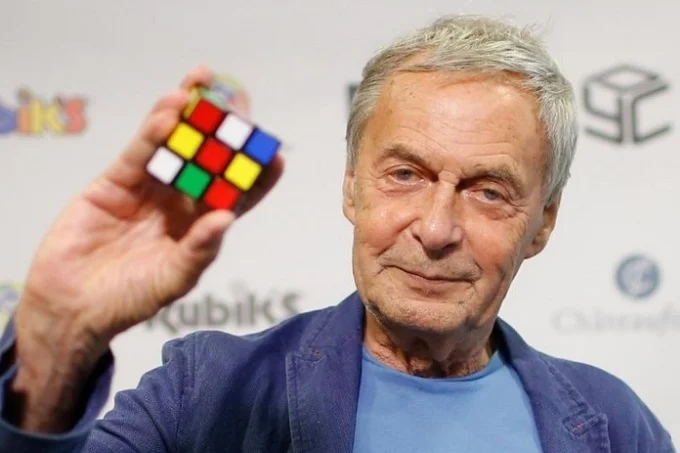Rubik’s Cube can be called a worldwide sensation. It is unlikely that at least one other toy is so popular in almost every corner of the planet. Hungarian sculptor Erno Rubik invented the most famous puzzle in the world in 1974 as a teaching tool for architecture students.
Confidently overcoming state borders, a simple-looking toy with multi-colored edges took over the world with unprecedented ease. And it took the inventor himself a month to assemble the Cube for the first time.
Little known creator
In 1974, a young and at that time unknown teacher at the Faculty of Design, Erno Rubik, was thinking about non-standard approaches to presenting material to students. The future 1st official millionaire of the bloc of Eastern European socialist states was fond of three-dimensional geometric modeling, seeing this as a suitable means of developing student skills in spatial imagination.
According to the popular version, this textbook allowed the teacher to explain to students the basics of mathematical theory intelligibly. The project of an outstanding invention, Rubik, hatched for several years. The first model was a bunch of 27 multi-colored wooden cubes (in total – 156 colored faces). The inventor decided to create a three-dimensional figure, the individual cubic parts of which can rotate around themselves without violating the unified design of the entire device.
The subsequent project eliminated all unnecessary. Erno left only 54 outer faces in the Cube: the central 6 cubes have the same color, 12 side cubes have two colors, and 8 corner cubes have three colors. In other words, the version of the Rubik’s Cube that we know today. The inner cavity was occupied by a cylindrical mechanism, which firmly fastened all the outer parts and at the same time allowed them to rotate freely relative to each other. This version of the tutorial turned into a toy.
A toy for children that captured the hands of adults
Rubik’s friends and his students from the Academy of Applied Arts were the pioneers of the puzzle. At that time, the communist regime of Hungary did not provide for entrepreneurial skill, so Rubik patented the toy after some time.
The “cube boom” happened by 1980, when the Ideal Toy Corporation acquired the license to manufacture the Rubik’s Cube puzzle. The first order amounted to a million copies, after which the toy became famous all over the world.
In the winter of 1980, the enchanting debut of the Rubik’s Cube took place. The intricate puzzle made its debut at the leading toy fairs in London, Paris, Nuremberg, New York. On May 5, the American premiere in Hollywood thundered, where the Cube was represented by movie star Gabor.
Despite the start of mass production, there were not enough cubes for everyone. Then the first fakes appeared in unthinkable volumes, and the Rubik’s Cube fell into the hands of every tenth representative of the civilized world.
The Rubik’s Cube first settled in schools, where the guys in the classes persistently twirled all the changes through it. On the other hand, the teachers had to fence themselves off from the students with a class magazine, not finding the strength to wait for the break. So the Cube also migrated to the teachers’ rooms, and soon the bright edges caught the eye in transport, offices, at a party, and on vacation.
In educational institutions and enterprises, informal competitions for high-speed assembly were organized. Almost the entire country knew the names of those who managed to collect the Cube in a matter of minutes in the first years of popularity. By the way, the inventor Rubik himself assembled the puzzle for the first time for about a month. The toy has become the most desired thing. It came to curiosities.
“We spin the cube, and the cube spins us,” the creator said about his creation. Its worldwide sales revenue is a multiple of that of Barbie dolls. In 1980 alone, buyers crushed at least 200 million toys worth about $12 Billion, bringing Rubik fabulous money. The Budapest teacher instantly became the first official dollar millionaire in the socialist camp.
Mankind greedily rushed to look for possible assembly algorithms. But there was no universal scheme. The Rubik’s Cube could be solved in a myriad of ways. To solve the puzzle, millions of people around the world turned on logic and ingenuity. Today the Internet comes to the rescue, ready-made video instructions, and diagrams. And at that time, each collected Cube was an achievement.
In the first year of sales, the puzzle received a national prize in Hungary, having received the title of “Best Invention of the Year” and winning competitions for the best toy in the UK, USA, France, and Germany. In 1981, the Rubik’s Cube entered the New York Museum of Modern Art. A month later, in England, a limited edition version of the Cube was released – Royal Puzzle, dedicated to the marriage of Prince Charles and Lady Diana. In prestigious European restaurants, the Cube has entered the list of fundamental serving items along with salt and pepper shakers.
Almost all world publications printed articles devoted to the Rubik’s Cube. The materials on puzzle assembly methods were the most popular. This printed phenomenon also affected several media. The same “Young Technician” published in 1982 an article with detailed illustrations on how to assemble faces by color. A little later, a similar article appeared on the pages of the authoritative journal Science and Life.
English psychologists undertook to study the phenomenon of the Cube at the scientific and medical levels. As part of a deep experiment, they observed great apes who were asked to assemble a puzzle. At first, the chimpanzees, who showed a strong interest in the bright little thing, became restless and sometimes even fell into despair. And for the sake of justice, it must be said that people reacted similarly to failures.
